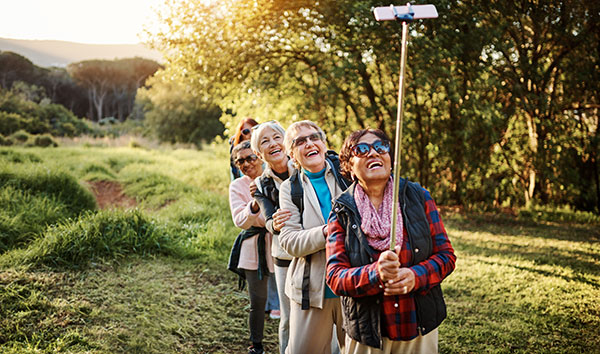By Martha Boudreau
Chief Communications and Marketing Officer,
AARP
Download PDF
Consumers’ opinions of what constitutes a desirable lifestyle are shaped by a continual stream of images and messaging from the mainstream media. Images, content and fashion models that surround consumers are central to driving the consumer belief system. Women have been programmed to believe that a beautiful body is thin and tanned. Women are led to believe that makeup is essential in order to be attractive. And, women are led to believe that youth is the only time in life when you are considered beautiful.
Luckily, times are changing and many (but not all) consumer health and beauty product manufacturers are embracing a much more diverse definition of beauty. Many of these health and beauty product companies, such as Dove, are creating advertisements that show women with different hair colors and textures, different body shapes and a multitude of skin colors. However, with the exception of L’Oreal, almost none have embraced age as a factor of diversity in their ads.
This lack of age representation in the media, marketing and advertising industries is shocking. Consider AARP’s study on beauty and wellness: 81 percent of women said they would rather buy a brand that shows a mix of ages in its ads, but 86 percent of women 50-plus felt underrepresented in ads and two-thirds said when they were represented, the images were selling old stereotypes.
 Many marketers believe their strategy should be to attract consumers younger in their lives in order to create a multi-decade purchasing relationship. However, what’s remarkable is that when those loyal consumers turn 50 years old, the companies that have enjoyed their brand loyalty for years turn their back on them, dropping them as a target audience purely because of age. Companies then, once again, pivot back to the younger demographic. This worn out strategy, of ignoring the older consumer, doesn’t make good business sense.
Many marketers believe their strategy should be to attract consumers younger in their lives in order to create a multi-decade purchasing relationship. However, what’s remarkable is that when those loyal consumers turn 50 years old, the companies that have enjoyed their brand loyalty for years turn their back on them, dropping them as a target audience purely because of age. Companies then, once again, pivot back to the younger demographic. This worn out strategy, of ignoring the older consumer, doesn’t make good business sense.
Reaping the economic benefits of age-inclusive marketing starts with understanding the 50-plus lifestyle and then using images and messaging that connect with the reality of how people are aging today. Increasingly, that lifestyle includes employment, which is tied to consumption and spending patterns.
AARP research has shown that consumers over 50 are responsible for more than 8.3 trillion of the country’s economic activity or 56 cents of ever dollar spent in 2018; and workers 50-plus make up over a third of the U.S. workplaces in key sectors such as technology, health and education. The 50-plus age group also strengthens communities across the U.S. by providing $745 billion in unpaid activities such as volunteering and caregiving and $97 billion in charitable donations.
How the 50-plus are spending their money also tells an important story for marketers. Adults 50-plus are responsible for $142 billion of spending in the travel industry and $1.2 trillion in the leisure industry, according to AARP research. These eye-popping stats should be interpreted as a call to action for consumer-goods companies and their marketing firms to reexamine stereotyped portrayals of older people, who often are shown only in health care settings or with a caregiver. Many images show older people in passive environments and rarely in the workplace, traveling, or socializing.
After witnessing too many of these typecast depictions, we at AARP knew it was time for a new image of aging to help marketers and the media accurately depict aging consumers. In 2019, we partnered with Getty Images to launch the Disrupt Aging® Collection of stock images. For two years now, advertisers and media have been empowered to present an accurate picture of aging.
Imagery in marketing is essential to product sales, but imagery in entertainment is what drives the broader societal discussion. At AARP we know the power of the entertainment industry. For more than two decades, through our Movies For Grownups awards program, we have recognized and awarded movie studios, actors and writers who create movies and television programming that taps the talent of the 50-plus and write stories that appeal to all generations. Afterall, entertainment is a top American export and all ages should be celebrated.
The UN’s 2020 aging report said there were 727 million adults 65 and older in the world and over the next three decades, that number is expected to more than double to over 1.5 billion in 2050. That’s a lot of people with substantial spending power. At AARP, our call is to the world’s media, entertainment, and marketing industries to look at the data, shed outdated stereotypes, and embrace the reality that the future is about a global aging population. There is much to celebrate about this burgeoning consumer market. But the first step is recognition of this diverse and expansive market. And then comes a proper depiction of what it is: a market characterized by a vibrant, engaged and consumer-focused lifestyle, and one that can be tapped to transform economies around the world.
about the author
Martha Boudreau is AARP’s chief communications & marketing officer. She is responsible for setting enterprise brand and communications strategy and unifying AARP’s voice throughout the organization’s extensive channels: social, digital, earned media and paid media along with AARP’s leading publications, AARP The Magazine and AARP Bulletin.